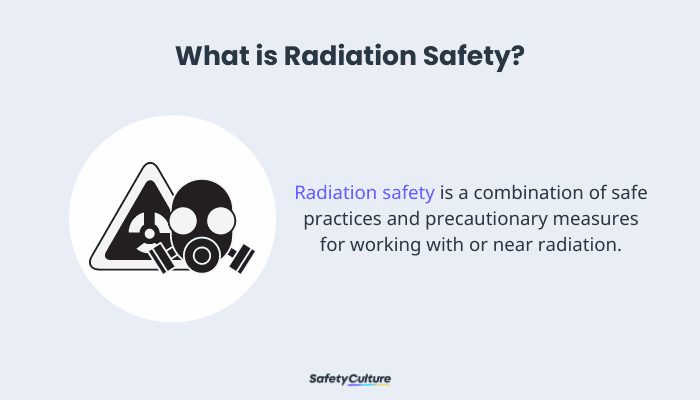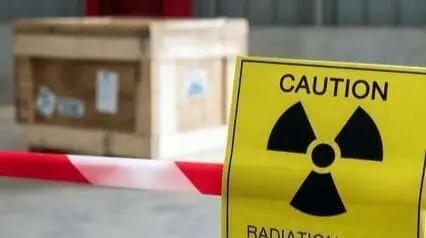What is Radiation Safety?
Also called radioactive safety, radiation safety is a combination of safe practices and precautionary measures put in place to promote safety when working with or near radiation. It follows the guiding principle ALARA or “as low as reasonably achievable.”
The Center of Disease Control’s definition of ALARA basically means to avoid it if you don’t need it even in small doses, this is made specifically for radiation. The ALARA radiation safety principle is to minimize radiation dosage and control the amount of radioactive materials in the environment to ensure workplace safety. There are numerous organizations that prescribe following radiation safety standards such as International Atomic Energy Agency (IAEA), Nuclear Energy Institute (NEI), and Occupational Safety and Health Administration (OSHA).
IAEA stresses the need for international radiation safety standards since most countries have inadequate or lack such standards. These international standards were set by a worldwide consensus, with the knowledge on biological effects and fundamentals of protection in consideration. The IAEA used the International Commission on Radiological Protection (ICRP)’s advice regarding radiation safety and related medical applications. This led to the creation of IAEA Safety Standard which is divided into 3 parts: Safety Fundamentals, Safety Requirements, and Safety Guides. Meanwhile, NEI utilized mostly data from two reports from National Academy of Sciences (NAS) and United Nations Scientific Committee on the Effects of Atomic Radiation (UNSCEAR) to form their radiation safety standards. The standards from NEI are focused on the public and workers that are or can be exposed to Nuclear radiation. This type of radiation can bring immediate harm to the human body with effects that could lead to death within a few hours. There are more organizations involved in the advocacy of radiation safety but all of them strive to achieve one goal – to keep people informed and secured.
With multiple organizations individually and collectively joining forces for radiation safety, its importance is undeniable. Many industry workers can be exposed to radioactive materials or radiation such as employees from healthcare and nuclear energy. Keep your employees safe by incorporating radiation safety measures in the workplace.

What is Radiation?
In layman’s terms, radiation is energy given off by matter that travels in the form of waves, rays, or other particles. Numerous branches of scientific studies such as physics, biology, chemistry, and epidemiology have concepts in connection to this type of energy, each with different definitions and areas of focus. In physics, the focus is on the energy it emits which is similar to the basic definition, while for biology, it’s the possible interaction of the ionizing radiation energy with molecules of the cells. The most common form of radiating energy is electromagnetic radiation. This classification includes radio waves, light, sound, and x-rays. Natural radiation can also occur in the environment, even the earth is a source of terrestrial radiation. In people’s perception, radiation, especially nuclear radiation, is harmful. History has taught mankind the destruction and long-term effects caused by radiation—from atomic bombs used during the second world war to the Chernobyl accident caused by nuclear power plant failure.
However, not so long ago, people weren’t aware of the dangers that could result from exposure to radiation, until the scientist Marie Curie discovered the radioactive element Radium. She later died of aplastic anemia, a disease connected to high radiation exposure. To this day, her body and belongings are still radioactive and will remain so in the next 1,500 years. A few years after Curie’s death, synthetic radium was mass produced and put in everything due to its luminous properties. Products made out of this element were found in everyday objects such as food, water, cosmetics, watch and clock faces. People believed that consuming radium will treat their arthritis, impotence and other ailments due to the widespread claim of its healing abilities. Another claim is that keeping radium near will invigorate the people around it. Even watch and clock faces were painted using radium to make it glow in the dark. These popular practices and products didn’t have adverse effects at first, but prolonged exposure led to fatalities or terminal diseases such as cancer. Radium is still present in household products to this day, but only in amounts deemed safe. Some materials naturally contain the radioactive element their use is heavily regulated by safety agencies or the government.
5 Common Myths About Radiation
It’s important to separate facts from fiction. There’s a lot of uncertainty regarding radiation and articles online can contain dubious information. Check whether the information your reading came from a credible source such as known health, science, and safety organizations. Here are some myths and its corresponding fact:
Myth: All radiation is bad
Fact: Only some are. Radiation has a bad reputation especially because of news outlets reporting mainly about the negative side of it. People are unaware that radiation is present in nature and could occur organically. A possible scenario for harmful radiations like nuclear radiation is when a nuclear power plant fails and you were present in the location of the blast. This causes immediate and long-term effects such as cancer. Technology has greatly improved since then and failures such as this were always preventable. Radiation is utilized in various industries such as agriculture, medical, mining, electricity. Archeologists and geologists can also make use of radiation in cases such as carbon dating. Everyday objects emit low amounts of radiation. Consumers who are concerned with radiation should buy products that passed standards.
Myth: Medical equipment that uses radiation will make you sick and radioactive
Fact: Medical equipment is produced with safe radiation standards. The patient’s exposure to radiation from the equipment is quick and miniscule enough so that it will not cause sickness. The most common medical equipment that uses radiation is the x-ray machine. This machine uses electromagnetic waves and various studies cleared it as safe as long as the machine operator followed instructions correctly and the machine is well maintained. Another example is the CT scan which helps diagnosis via nuclear imagery. The targeted ionizing radiation emits in low dosage but the more CT scans a patient has, the higher the radiation exposure is. Experts believe that radiation-related risk of people above 65 years old from using a CT scan is insignificant to none. Relatively, CT Scans are safe and it will take 5 decades for a middle aged patient to develop cancer while a person above 65 years of age around 20 years or more.
Myth: Living near a nuclear plants causes cancer and other ailments
Fact: There is no effect to people and animals just by being near an accredited nuclear plant as long as the nuclear reactor is functioning properly. Only direct exposure to nuclear radioactive materials and air will lead to diseases that are linked to radiation. The nuclear energy industry has learned from the Chernobyl incident and adopted radiation safety standards. Most plants are located in a safe distance away from residential communities and follow protocols.
Myth: Radiation cause body mutations
Fact: No, radiation will not cause a person to mutate and gain supernatural abilities. People also mistake deformities caused by radiation as mutations which are entirely part of a different category. Radiation is a mutagen which changes the genetic material of a cell. This causes a higher possibility of a genetic mutation to occur. Most mutations are harmless and the body can recover itself but there are rare cases that cancer can develop. Radiation can also cause hereditary genetic mutations if the cells affected were gametes. The animals in Chernobyl are considered mutants despite the normal appearance. The reason for this is because the mutation only changed the genetic makeup of their cells. The animals from Chernobyl also experience domestic genetic deformities because of radiation.
Myth: don’t sleep next to your phone due to radiation
Fact: A person’s sleeping routine is affected by other things which are not related to radiation. Studies show that a mobile does emit low amounts of radiation but not enough to cause effects such as sleep disturbance. A lot of news and blog articles spread this narrative on baseless information and without scientific evidence. Experts are still conducting research on long-term effects of sleeping beside your phone. The National Cancer Institute has already stated that phones don’t cause cancer. Factors such as using your phone before you sleep can be the cause of your sleep problems. Try to turn off or stop using your phone 30 minutes before you plan to sleep.
Do Electronic Devices Emit Radiation?
Radiation is found everywhere. Everyday objects such as personal electronics emit low amounts of radiation. The types of radiation can be electromagnetic, radio waves or other generally non-harmful radiation energy. Electronics such as cell phones, microwave, and radio will not harm a person who uses them regularly. Some devices need extra precautions such as the medical equipment, x-ray and CT scan. Any metal object should be removed before operating the machine because it can interfere with the electromagnetic field and obscure the view of the specific anatomy. Many people believe that using their microwaves causes them to get headaches. The Cancer organization stated there is no link between this claim when the appliance is used according to the instructions. Radiation standards also limit the amount of radiation emitted to a low level, in this device its radio frequency.
Radiation for Medical Treatment
Radiation is utilized in a lot of medical treatments and equipment. Radiation therapy or radiotherapy is a cancer treatment that kills cancer cells and reduces tumors. Normal cells can heal and repair themselves while cancer cells can’t. Prior to this treatment, a patient will be requested to take a CT scan to locate the area of the cells that needs to be removed. The 2 types of radiation therapy is external beam and internal. The machine that administers external beams radiotherapy is called a medical linear accelerator. There are many external radiation therapy a patient can choose from such as three-dimensional conformal radiation therapy, intensity modulated radiation therapy, and proton beam therapy. Brachytherapy, an internal radiation treatment, is administered by directly placing radioactive sources on the target area inside the body. This cancer treatment doesn’t immediately eliminate the cancerous cells, it happens gradually and differs per person. The National Cancer Institute says that radiation therapy is quick and painless. A risk for this treatment is that cancer patients and survivors may have a shorter lifespan due to repeated and intensive radiation treatment and as well as chemotherapy. Another effect is it weakens the immune system which can leave the patients vulnerable to other diseases. People who undergo radiotherapy should expect extreme fatigue and hair loss. Patients can also experience skin changes, skin irritation, mouth soreness. These effects will vary depending on the patient’s ailment. These are manageable and can be treated. What’s important is to remove cancer cells and be cured of the illness.
What are the Risks of Radiation?
There are multiple industry workers that are exposed to or handle radiation. Professions such as nuclear workers, medical workers including dentists, pilots, and radiologists to name a few. Several studies have been conducted for the connection between workers who are regularly exposed to radiation and ailments such as cancer and leukemia. Decades of research has concluded that these workers have a higher probability of radiation related risks but not necessarily lead to sickness.
An estimated total of 23 million workers are exposed to artificial and natural radiation globally. Exposure to any amount of radiation presents a risk of damage to cells or tissue. While our bodies have the ability to repair damage cells, over time if exposure becomes longer and greater, it can result in many acute injuries such as burns, acute radiation syndrome, and long term health problems such as cancer and cardiovascular diseases.
What Happens if a Person is Radioactive?
People’s bodies are naturally radioactive. The amount of radioactivity varies per person due to factors such as location and diet. Experts assure that the level of radioactivity is normal unless there are additional variables and scenarios. A highly radioactive person or a person suffering from acute radiation syndrome also known as radiation sickness will need to undergo a medical examination to determine how severe the illness is likely to be, and decide which treatment to use to help the person survive. However, it is important to note that a person who’s absorbed large doses of radiation will have a small chance of recovery.
Nuclear waste and its effects on the environment
Nuclear reactors, plants, hospitals, mining, and other facilities generate radioactive waste. This hazardous wastes pose a threat to people, animals, and the whole ecosystem. Managing radioactive waste isn’t that different from other industrial waste. There are 3 classifications which are low, intermediate, and high activity levels. Companies should follow protocols and regulations to ensure that these are disposed of properly and minimize environmental impact. It is recommended to isolate and contain these waste away from the environment. Nuclear waste can also be recycled and reused. This is usually done by nuclear energy firms that use uranium as a fuel to create electricity. Another option is to burn the radioactive waste at the end of its useful life.
What are the 3 Principles of Radiation Safety?
According to the CDC, radiation exposure risks can be lowered by following the three principles of radiation safety which is time, distance, and shielding. These are also known as the basic protective measures in radiation safety.
Time
This refers to the amount of time spent near the radioactive source. Time near the radioactive source should be kept at a minimum. Tasks or work activities revolving around the radioactive source should be done quickly as possible, to reduce spending time around the radioactive area more than necessary.
Distance
This refers to the distance between a person and the radioactive source. The greater the distance the lesser exposure and dose of radiation workers will be exposed to.
Shielding
Exposure to radiation sources can be minimized through shields. Shielding refers to putting something in between the radiation source and the person involved. The effectiveness of shields will vary depending on the level of radionuclides the radiation source is emitting.
Radiation Safety Measures
Radiation safety measures such as conducting safety inspections help ensure that critical radiation safety precautions are in place to reduce the risk of overexposure. There should be visible warning signs, contamination surveys conducted, and device tests for all radiation-producing equipment. All workers must be trained to limit time of exposure, use radiation shields, and increase the distance of contact with radioactive devices and materials.
Create Your Own Radiation Safety Checklist
Eliminate manual tasks and streamline your operations.
Get started for FREE10 Tips for Radiation Safety
Everyone must take radiation overexposure seriously. Hence, preventive measures and rules must be strictly followed to avoid critical health conditions. Here are top 10 list of rules to remember when working with radiation:
- Acquire adequate training to better understand the nature of radiation hazards.
- Reduce handling time of radioactive materials and equipment.
- Be mindful of your distance from sources of radiation. Increase distance as much as possible.
- Use proper shielding for the type of radiation.
- Isolate or contain harmful radioactive materials properly.
- Armor yourself with appropriate protective clothing and dosimeters.
- Conduct contamination surveys in the work area.
- Do not eat, drink, smoke, or apply cosmetics in an area where unsealed radioactive substances are handled.
- Observe proper radioactive waste disposal
- Conduct regular radiation safety self-inspections
SafetyCulture Marketplace: Your One-Stop Work Gear & Equipment Shop
Improve safety in your workplace with SafetyCulture Marketplace as your one-stop shop for all work gear and equipment needs. Get on-demand access to top quality and specialized work gear from trusted equipment brands in the industry—all in one centralized location. Raise the bar of safety and efficiency by empowering employees to request what they need with just a few taps, anytime and anywhere!
Utilizing Technology to Implement & Maintain Radiation Safety
SafetyCulture (formerly iAuditor) is an award winning software for health and safety. It can help with streamlining and implementing radiation safety measures. Minimize the risks and achieve radiation safety by conducting regular inspections to confirm compliance, identify hazards, and control it. With iAuditor, you can:
- Easily conduct safety inspections using a tablet or mobile device.
- Proactively capture issues outside or during an inspection. With iAuditor’s collaborative actions feature, teams are able to instantly raise issues and assign the appropriate corrective action for immediate resolve.
- Produce comprehensive reports automatically. Reports are generated upon completing an inspection.
- Track and monitor how safety measures and radiation safety best practices are being performed across departments and sites with analytics.
- Easily customize safety checklists and inspection forms where you see fit and share them with your team to collect consistent data across sites.
- Train employees on proper safety procedures and handling practices.



